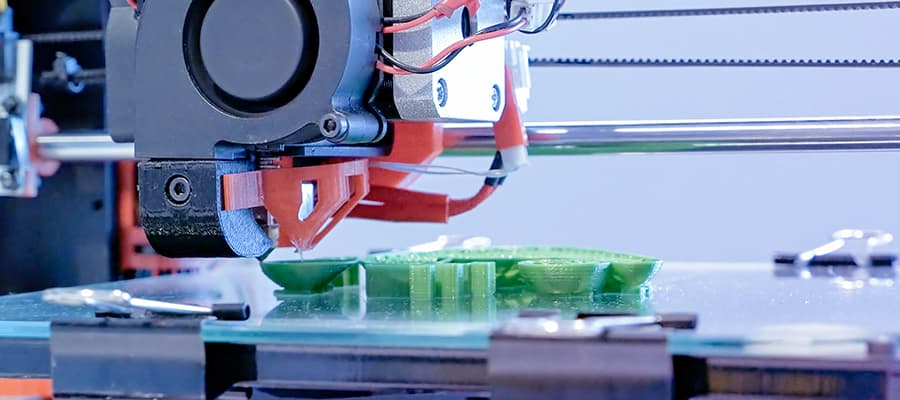
GxP Lifeline
Additive Manufacturing in the Medical Device Industry

Additive manufacturing (AM), often referred to in industrial applications as 3D (three-dimensional) printing, is a method of forming objects by adding raw material layer-by-layer. The process of developing any 3D-printed object can vary with different AM technologies and combinations of processing steps. Nevertheless, all printers require some kind of additive manufacturing software with functionality for design, inspection, printing, and scanning. In many industries, AM is frequently used for product research and development. However, in some areas, such as additive manufacturing for medical devices, companies are actually employing the technology for commercial production of devices.
AM Is Becoming More Popular and Profitable for Medical Device Manufacturing
The AM industry is growing rapidly as companies making a digital transformation in manufacturing continue to discover and develop more products with the technology. In 2021, 3D printer manufacturers shipped 2.2 million printers, making the AM market value $13.84 billion — with no signs of slowing. Based on a report from Grand View Research, the market is expected to expand at a compound annual growth rate (CAGR) of 20.8% from 2022 to 2030.1
Who Is Using AM?
Currently, automotive, aerospace, and marine industries are using AM in various capacities because the products are light weight and can withstand harsh environmental conditions. In the medical field, the most common uses are in AM for medical devices, which include personalized medical implants, medical models, splints, and artificial tissues and organs.
Medical research institutions, doctors, and patients have all benefitted from AM due to its ability to create a variety of products with high precision and accuracy. For example, it has been useful for surgical and study purposes as well as for tools used in dental procedures, pre-surgery models for CT scans, custom saw and drill guides, enclosures (cabinets used to house dental equipment, such as regulators that distribute air and water), and specialized instrumentation.2
Meeting the Precise Needs of Complex Medical Devices
One of the major benefits of AM for medical devices is the ability to affordably customize products. AM enables the creation of light, complex designs that are often too difficult or costly to build using traditional machines and methods. Product developers can design and produce highly complex parts and components and, ultimately, create patient-specific devices or devices with very complex internal structures. For example, AM enables the creation of patient-matched devices by using the person’s own medical imaging.
Moreover, AM is largely beneficial in the medical field because it’s helpful with complex operations. Using 3D-printed objects to show the image of a patient’s actual organs allows doctors to gain practical knowledge by performing surgical procedures on the objects.3
In June 2020, mechanical engineers and computer scientists at the University of Minnesota discovered another application of AM for medical devices. They learned that sensors can be 3D-printed directly onto living, moving human organs. Using motion capture technologies, similar to those used to create special effects in many modern movies, the team was able to print electronic, hydrogel-based sensors on organs like lungs that are constantly contracting and expanding.
The new 3D printing technique could have applications in diagnosing and monitoring the lungs of patients with COVID-19. At some point it may also be used to print sensors directly on a pumping heart.4
Additive Manufacturing Accelerates Time-to-Market
Contributing to the life sciences industry’s digital transformation in manufacturing, another key benefit of AM for medical devices is shorter manufacturing lead time. Advancing AM technology enables designers and engineers to quickly create and iterate designs and produce parts. Due to its flexibility, 3D printing lets designers make changes easily without having to set up additional equipment or tools, meaning any design iterations of a 3D printed-device can often be done in a matter of hours, speeding up time-to-market for a new device.
Regulators Weigh In on AM
In December 2017, the U.S. Food and Drug Administration (FDA) published the guidance “Technical Considerations for Additive Manufactured Medical Devices.” The agency acknowledged that the technological advancements and availability of fabrication equipment are encouraging more investment and use by the medical device industry.
Given the different technologies and different combinations of 3D printing that can be used with each technology, the guidance cannot address every possible scenario of AM. However, it does point out aspects of AM and the products that apply to device manufacturers using the technology.
FDA’s Traditional Requirements Still Apply
The FDA will always remain deeply rooted in its pledge to uphold the safety, efficacy, and security of human and veterinary drugs. As product development processes for new technologies advance, the agency must ensure that companies are still adhering to this paradigm. As with product development, the agency has requirements that apply to the manufacturing methods and processes used that are designed to ensure consistent and reliable production of a device.
When employing AM for medical devices, the guidance recommends that manufacturers compare the desired feature sizes of their finished device to the minimum possible feature size of their AM technique and the manufacturing tolerances of the individual machine, given the build parameters and conditions under which the final device is expected to be made. Again, this is to ensure that devices and components of the desired dimensional specifications can be consistently and reliably built using the chosen additive manufacturing technology.5
The inauguration of AM into mainstream health care product development is further evidence that digital transformation in manufacturing has become the norm. The competitive scale is tilting more in favor of those companies who have or are migrating to a digital manufacturing operation. Given how fast technology progresses these days, manufacturers lagging behind in modernizing their operations will find it extremely difficult to catch up with their industry peers.
For more information about current trends involving advanced technologies in life sciences, read the trend brief “Top 3 Trends in Personalized Medicine.”
References:
- "Market Analyst Report1. “Market Analyst Report,” Grand View Research, Oct. 2022.
- "Global Additive Manufacturing Market – Industry Trends and Forecast to 2030," Data Bridge Market Research, Dec. 2022.
- "Additive Manufacturing Applications in Medical Cases: A Literature-Based Review," Mohd. Javaid and Abid Haleem, Taylor and Francis Online, May 17, 2019.
- "Five Major 3D Printing Breakthroughs Seen in the Medtech Sector So Far This Year," Jamie Bell, Ns Medical Devices, Nov. 10, 2020.
- "Technical Considerations for Additive Manufactured Medical Devices," (Guidance for Industry), Dec. 5, 2017.

